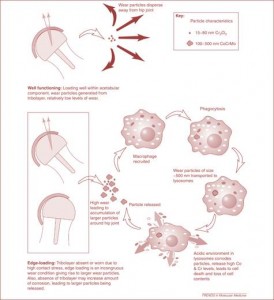More MOM Hip Replacement problems before Father’s Day
More hip resurfacing problems? As I’ve blogged before, metal on metal hips for hip resurfacing have evolved as a huge problem. The basic issue is the same with all artificial joint prostheses-wear particles. Any piece of metal, plastic, or ceramic you insert in the body that is designed to undergo significant friction will wear out and those pieces that wear off have to go somewhere. Where do they go? Into you! They end up inside the joint capsule, with surgeons reporting that on re operation these Birmingham hip joints are black with the stuff. They go into your blood stream, with metal ions from artificial hips being detected in the blood. Some people are also allergic to the metals used in the hip and knee replacement device, causing a new set of tissue reaction problems. In addition, the more we push knee and hip replacements into younger and younger patients, the more of these wear particles you get, as these patients are more active and thus wear the prosthesis more. On the heels of all of this, this week yet another metal on metal hip was pulled for device failure. The upshot? No matter what we make, it wears down. If you aren’t a candidate for biologic therapies for your hip or knee arthritis, then consider going with very low wear particle prostheses. This past few years knee and hip replacement manufacturers have been trying to design devices that wear less and produce fewer particles. These include the Zimmer Nexgen system. Better yet, catch your arthritis early and try to avoid the replacement altogether!

NOTE: This blog post provides general information to help the reader better understand regenerative medicine, musculoskeletal health, and related subjects. All content provided in this blog, website, or any linked materials, including text, graphics, images, patient profiles, outcomes, and information, are not intended and should not be considered or used as a substitute for medical advice, diagnosis, or treatment. Please always consult with a professional and certified healthcare provider to discuss if a treatment is right for you.

